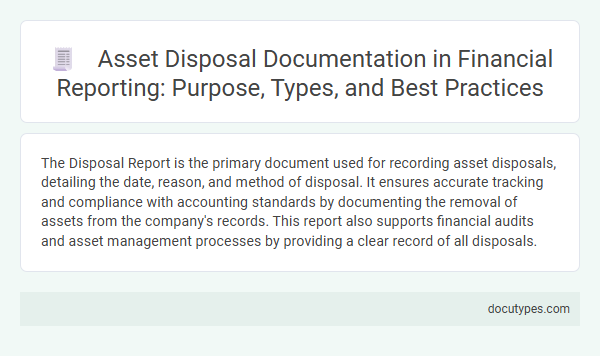The Disposal Report is the primary document used for recording asset disposals, detailing the date, reason, and method of disposal. It ensures accurate tracking and compliance with accounting standards by documenting the removal of assets from the company's records. This report also supports financial audits and asset management processes by providing a clear record of all disposals.
Introduction to Asset Disposal Documentation
Asset disposal documentation is essential for accurately tracking the removal or sale of company assets. It ensures proper recording of the asset's final status, value adjustments, and compliance with accounting standards. Common documents used include disposal forms, sales receipts, and asset retirement records to maintain transparency and audit readiness.
Importance of Proper Asset Disposal in Financial Reporting
Asset disposal records are documented using a Disposal or Asset Disposal Report, crucial for accurate financial reporting. Proper documentation ensures compliance with accounting standards and provides clear evidence of asset retirement or sale.
- Disposal Report Accuracy - Detailed records prevent misstatements in financial statements related to asset values and gains or losses.
- Regulatory Compliance - Maintaining disposal documentation supports adherence to tax laws and auditing requirements.
- Financial Statement Integrity - Accurate disposal records contribute to transparent reporting of company assets and liabilities.
Key Purposes of Asset Disposal Documentation
Documenting asset disposals is essential for maintaining accurate financial records and ensuring compliance with regulatory requirements. The primary document used for this purpose is the Asset Disposal Report, which captures all relevant details of the disposal process.
- Verification of Disposal - Confirms the asset has been properly removed from the company's inventory and accounting books.
- Audit Trail - Provides a clear record for auditors to examine the circumstances and legitimacy of the asset disposal.
- Financial Impact Assessment - Details any gains or losses resulting from the disposal, helping in accurate financial reporting.
Your use of the Asset Disposal Report safeguards transparency and accountability in managing company assets.
Types of Asset Disposal Transactions
| Type of Asset Disposal Transaction | Description | Common Document Used |
|---|---|---|
| Sale of Asset | Transaction involving the sale of a fixed asset such as machinery, vehicles, or equipment. The asset is removed from the books and proceeds are recorded. | Asset Disposal Form or Sale Invoice |
| Scrapping or Write-off | Disposal of assets that are no longer usable due to damage or obsolescence, usually recorded at net book value loss. | Asset Write-off Form or Disposal Authorization Document |
| Trade-in of Asset | Replacing an asset by trading it in for a new asset, often involving valuation of the old asset deducted from the purchase price. | Trade-in Agreement or Disposal Form |
| Donation or Gift | Asset is disposed of by gifting or donating to another organization or entity, requiring documentation for tax and audit purposes. | Donation Form or Asset Transfer Document |
| Abandonment | Assets discarded without resale value or recovery, formally removed from accounting records. | Asset Disposal or Abandonment Form |
Essential Components of Asset Disposal Records
What document is used for recording asset disposals? The Asset Disposal Form is the primary document utilized for this purpose. It contains essential components that ensure accurate and complete recording of asset disposals.
What are the essential components of asset disposal records? Key elements include asset identification details, disposal date, reason for disposal, disposal method, and financial information such as book value and disposal proceeds. These components provide a comprehensive record for auditing and financial reporting purposes.
Why is it important to include approval signatures in asset disposal records? Approval signatures from authorized personnel validate the disposal process and ensure compliance with company policies. Your organization relies on these signatures to maintain accountability and transparency in asset management.
Regulatory Requirements and Compliance
The primary document used for recording asset disposals is the Asset Disposal Form, which ensures proper tracking and authorization of asset removal. Regulatory requirements mandate accurate documentation to comply with financial reporting standards and audit trails. Compliance with these standards helps organizations avoid legal penalties and maintain transparent asset management records.
Common Methods of Asset Disposal
The document used for recording asset disposals is commonly known as the Asset Disposal Form or Disposal Register. This document tracks the details of the asset being disposed, including the method and date of disposal.
Common methods of asset disposal include sale, scrapping, donation, and trade-in. Each method requires proper documentation to ensure accurate accounting records and compliance with company policies. The disposal form captures necessary information such as asset description, disposal method, proceeds received, and authorization signatures.
Challenges and Risks in Asset Disposal Documentation
Asset disposal documentation typically involves a Disposal Notice or Asset Disposal Form, which records key details such as asset identification, reason for disposal, and approval signatures. Accurate documentation ensures compliance with accounting standards and legal requirements.
Challenges in asset disposal documentation include incomplete records, unauthorized disposals, and data mismanagement. These risks can lead to financial discrepancies, regulatory penalties, and operational inefficiencies affecting your asset management process.
Best Practices for Accurate Asset Disposal Recording
Accurate recording of asset disposals is crucial for maintaining up-to-date financial records and ensuring compliance with accounting standards. The primary document used for this purpose is the Asset Disposal Form, which details the specifics of the asset removal process.
- Asset Disposal Form - This document records essential information such as asset description, disposal date, reason for disposal, and approval signatures.
- Audit Trail Maintenance - Keep comprehensive records of disposal transactions to support audits and verify asset removal accuracy.
- Regular Reconciliation - Reconcile asset registers with disposal records periodically to ensure all disposals are properly documented and accounted for.
What Document Is Used for Recording Asset Disposals? Infographic

